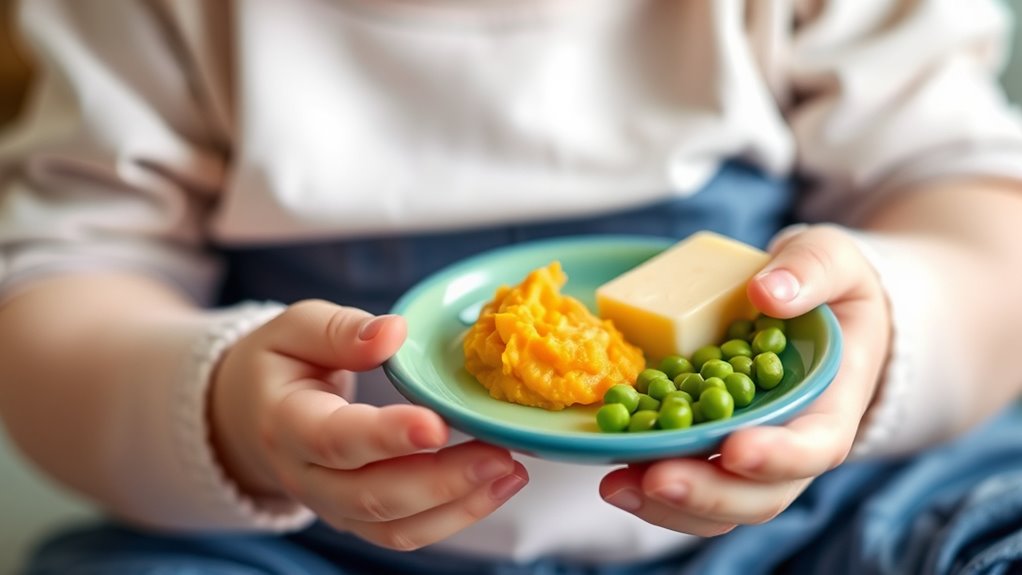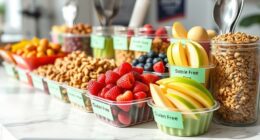When serving toddlers, start with about a quarter to a third of adult portions, typically 1-2 tablespoons of each food. Use measuring cups, spoons, or a kitchen scale to guarantee accurate, manageable amounts. Offer small portions first and watch for hunger or fullness cues. Building routine, consistency, and recognizing your child’s signals help create healthy eating habits. Keep in mind, adjusting as they grow supports their needs—continue exploring for more tips.
Key Takeaways
- Toddlers typically need about a quarter to a third of adult portions per meal, starting with 1-2 tablespoons of each food group.
- Use measuring tools like small cups, spoons, or a kitchen scale to serve accurate portion sizes.
- Serve consistent, small portions daily to establish routines and help toddlers recognize hunger and fullness cues.
- Offer initial small servings and allow toddlers to ask for more if still hungry, respecting their natural appetite.
- Gradually adjust portions based on growth, activity levels, and individual hunger signals to promote healthy eating habits.

Ever wonder how much food your toddler really needs at each meal? It’s a common question for many parents, especially when trying to balance nutrition without overfeeding. The key is understanding appropriate portion sizes and establishing mealtime routines that support healthy eating habits. Using measuring tools can be incredibly helpful here, as they give you a clear idea of how much food to serve without guesswork. Small measuring cups or spoons work well for liquids or small food items, while a kitchen scale can help you gauge more precise portions of solid foods. These tools take the guesswork out of serving sizes and ensure your toddler gets just enough to satisfy their hunger without feeling overwhelmed.
Building mealtime routines centered around consistent portion sizes helps your child develop a sense of security around eating. When you serve similar amounts each day and stick to a routine, your toddler learns what to expect, which can reduce fussiness and overeating. For example, offering a small plate with measured portions at the start of each meal creates a predictable pattern that encourages mindfulness about how much they’re eating. Over time, your child begins to recognize their own hunger cues and learns to listen to their body’s signals, fostering healthier habits down the line.
Consistent portion routines help toddlers feel secure and develop healthy eating habits.
It’s important to remember that toddlers have small stomachs—they typically only need about a quarter to a third of an adult portion at each meal. Serving too much can lead to waste or overeating, while too little might leave them hungry and cranky. A good rule of thumb is to start with a small portion, about one to two tablespoons of each food group, and then allow your child to ask for more if they’re still hungry. This approach respects their natural appetite and teaches them to listen to their body’s needs.
Incorporating measuring tools into your mealtime routines doesn’t mean you have to be overly strict; it’s more about establishing a foundation for healthy eating. As your child gets used to these portion sizes, you can gradually transition to serving based on their cues, still maintaining consistency. Keep in mind that every toddler is different, and growth spurts or activity levels can influence their appetite. Regularly observing your child’s hunger and fullness cues will help you fine-tune portion sizes and keep mealtimes calm and positive. Additionally, understanding the best vacuum options for cleaning can help maintain a tidy environment that encourages positive mealtime routines and reduces distractions. Ultimately, a balanced approach that combines measuring tools, mealtime routines, and attentive observation will set your toddler up for a lifetime of healthy eating habits.
Frequently Asked Questions
How Can I Tell if My Toddler Is Overeating?
You can tell if your toddler is overeating by watching for signs like consistently stopping only when full or showing no interest in food during meals. Picky eating might hide overeating, so focus on growth monitoring—if they’re gaining weight rapidly or seem overly full after small portions, it’s a clue. Trust their hunger cues and avoid pressuring them, ensuring they eat balanced portions suited for their age.
Are Snack Portions Different From Meal Portions?
Snack portions are generally smaller than meal portions, emphasizing quick energy rather than sustained fullness. While a meal might include a balanced plate with proteins, grains, and vegetables, snack portioning focuses on light, manageable bites. You should offer snacks in smaller sizes to prevent overeating, knowing that meal portions are designed to satisfy longer hunger. Adjust your toddler’s snack size based on their activity level and overall daily intake.
How Do Portion Sizes Vary for Toddlers With Food Allergies?
You should adjust portion sizes for toddlers with food allergies by following safe portion guidelines, ensuring they get enough nutrition without overfeeding. Use allergy-friendly snacks that are appropriately sized, and always check labels for allergen information. Keep portions smaller than typical, focusing on variety and balance. This approach helps prevent allergic reactions and supports healthy growth while respecting individual needs.
When Should I Introduce New Foods in Small Portions?
You should introduce new foods, including vegetables and finger foods, gradually and in small portions. Wait 3 to 5 days before trying another new food to monitor for allergies or reactions. Start with tiny tastes of vegetables and gradually increase the portion size as your toddler shows acceptance. This approach helps guarantee safety while encouraging your child’s curiosity and development of healthy eating habits.
Do Portion Sizes Differ for Active Versus Less Active Toddlers?
Your toddler’s portion sizes do vary based on activity level, which impacts their calorie needs. An active toddler requires considerably more food to fuel their energy burns, so you should increase their portions accordingly. Less active toddlers need smaller servings to prevent overeating. Keep an eye on their cues and adjust portion sizes to match their energy expenditure, ensuring they get enough nutrition without overfeeding.
Conclusion
Knowing the right portion sizes helps guarantee your toddler gets the nutrition they need for growth and development. Remember, about 80% of parents worry they’re giving too much or too little, so trust your instincts and focus on your child’s hunger cues. Offering appropriate portions supports healthy eating habits now and sets the foundation for a lifetime of good nutrition. Keep informed, stay flexible, and watch your little one thrive!









